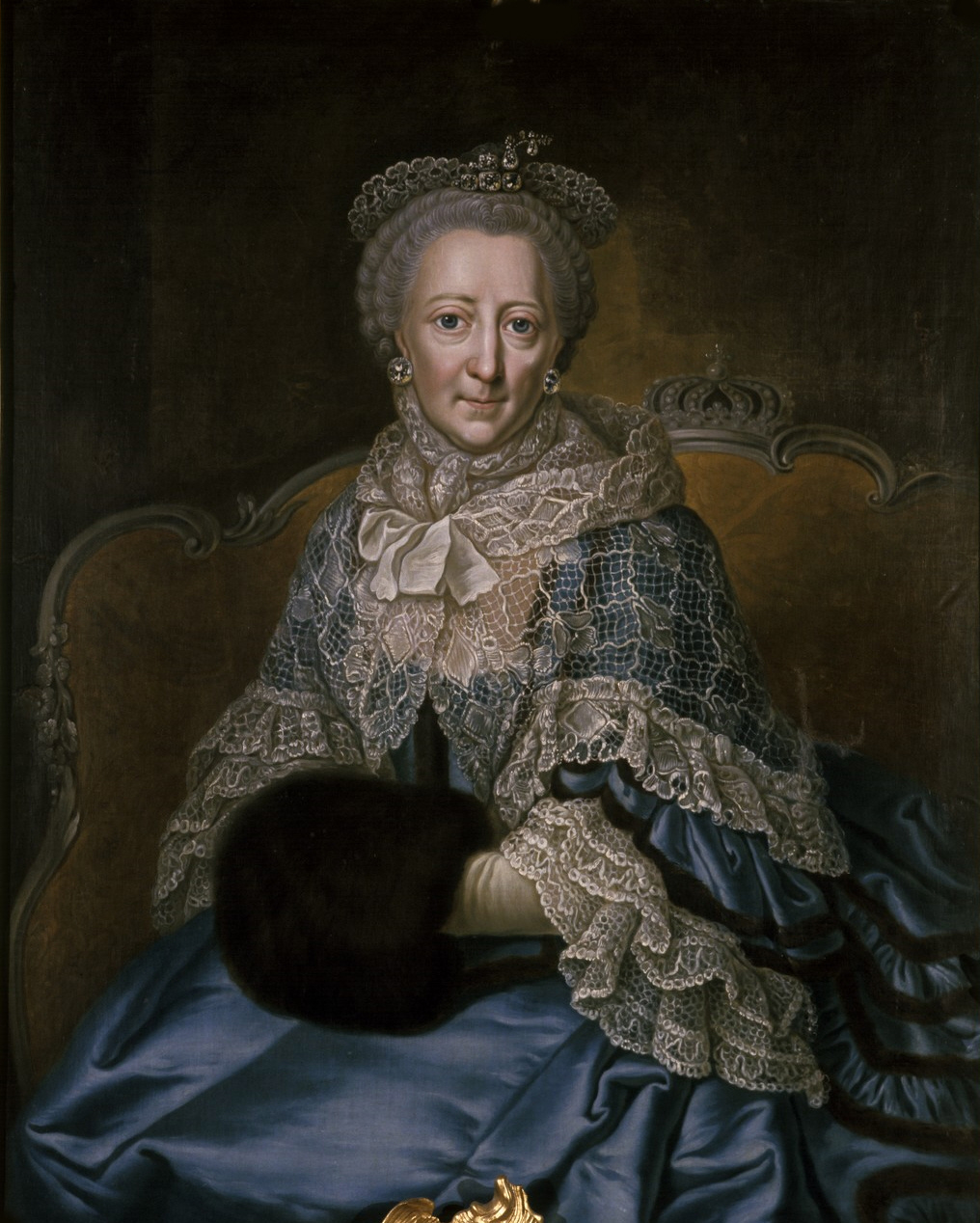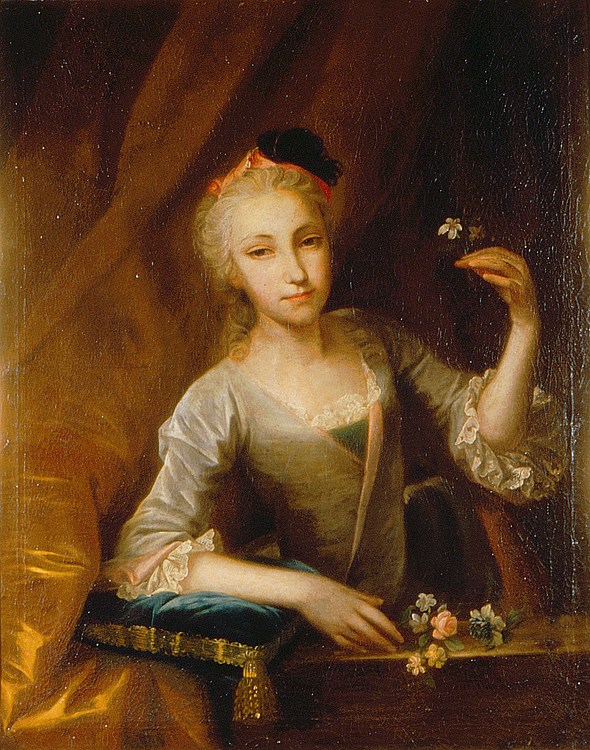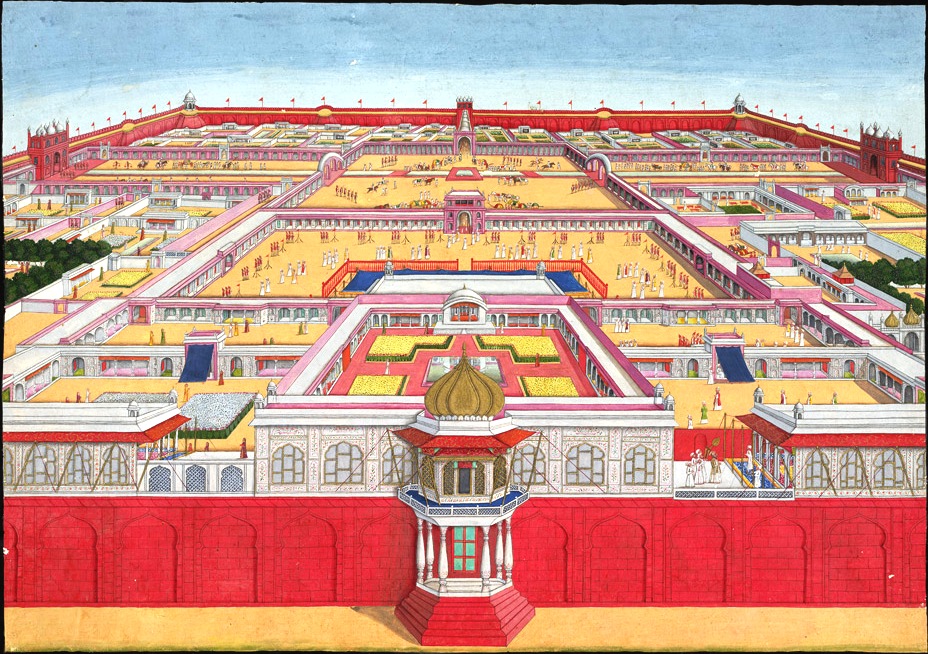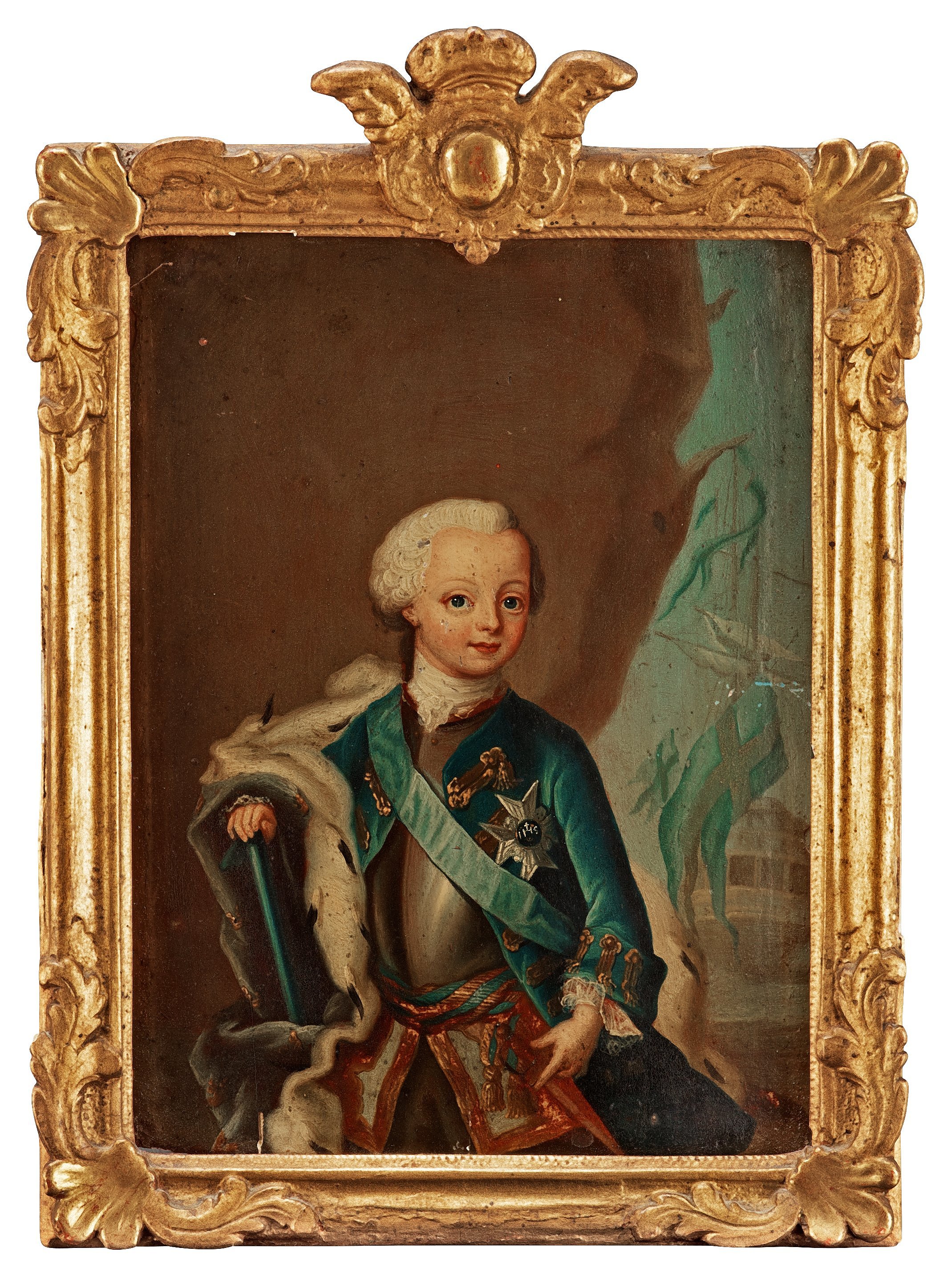|
Princess Philippine Charlotte Of Prussia
Princess Philippine Charlotte of Prussia (13 March 1716, in Berlin – 17 February 1801, in Brunswick) was Duchess of Brunswick-Wolfenbüttel by marriage to Duke Charles I. Philippine Charlotte was a known intellectual in contemporary Germany. She is listed as a female composer as she is thought to have written marches and other music. Life Philippine Charlotte was the fourth child and third daughter of Frederick William I of Prussia and his wife Sophia Dorothea of Hanover (those who reached adulthood; she was otherwise seventh child and fourth daughter). On 2 July 1733 in Berlin, Princess Philippine Charlotte married Duke Charles of Brunswick-Wolfenbüttel, eldest son of Ferdinand Albert II, Duke of Brunswick-Wolfenbüttel. Charles inherited the dukedom on his father's death in 1735, making her Duchess consort. The double marriage alliance between Prussia and Brunswick by her marriage to Charles I, and that of her brother Frederick to Charles' sister Elisabeth Chris ... [...More Info...] [...Related Items...] OR: [Wikipedia] [Google] [Baidu] |
Francesco Carlo Rusca
Francesco Carlo Rusca, or Carlo Francesco Rusca, also known as Ritter von Rusca (1 January 1693 – 11 May 1769) was an itinerant Italian-Swiss painter, best known for his portraits. Life and work Little is known of his early life. He was born in Torricella, and studied law at the University of Turin, where he may have earned his Doctorate. He soon turned to painting, however, but had difficulty obtaining clients so, sometime in the 1720s, went to Venice and became a student of Jacopo Amigoni. The works of Titian and Paolo Veronese were especially influential. He first gained attention at this time with portraits of the Sardinian Royal Family. Later, he returned to Switzerland, working in Solothurn and Bern. His connection with Germany began when he married in St. Blasien. In 1733, he went to Kassel at the invitation of Landgrave William VIII, for whom he created several large portraits. His wife died in 1735 and, the following year, he moved to Hannover then, in 1 ... [...More Info...] [...Related Items...] OR: [Wikipedia] [Google] [Baidu] |
Charles I, Duke Of Brunswick-Lüneburg
Charles is a masculine given name predominantly found in English and French speaking countries. It is from the French form ''Charles'' of the Proto-Germanic name (in runic alphabet) or ''*karilaz'' (in Latin alphabet), whose meaning was "free man". The Old English descendant of this word was '' Ċearl'' or ''Ċeorl'', as the name of King Cearl of Mercia, that disappeared after the Norman conquest of England. The name was notably borne by Charlemagne (Charles the Great), and was at the time Latinized as ''Karolus'' (as in ''Vita Karoli Magni''), later also as '' Carolus''. Some Germanic languages, for example Dutch and German, have retained the word in two separate senses. In the particular case of Dutch, ''Karel'' refers to the given name, whereas the noun ''kerel'' means "a bloke, fellow, man". Etymology The name's etymology is a Common Germanic noun ''*karilaz'' meaning "free man", which survives in English as churl (< Old English ''ċeorl''), which developed it ... [...More Info...] [...Related Items...] OR: [Wikipedia] [Google] [Baidu] |
1737 Sofie Karoline
Events January–March * January 5 – Spain and the Holy Roman Empire sign instruments of cession at Pontremoli in the Grand Duchy of Tuscany in Italy, with the Empire receiving control of Tuscany and the Grand Duchy of Parma and Piacenza, in return for Don Carlos of Spain being recognized as King of Naples and King of Sicily. * January 9 – The Empires of Austria and Russia enter into a secret military alliance that leads to Austria's disastrous entry into the Russo-Turkish War. * January 18 – In Manila, a peace treaty is signed between Spain's Governor-General of the Philippines, Fernándo Valdés y Tamon, and the Sultan Azim ud-Din I of Sulu, recognizing Azim's authority over the islands of the Sulu Archipelago. * February 20 – France's Foreign Minister, Germain Louis Chauvelin, is dismissed by King Louis XV's Chief Minister, Cardinal André-Hercule de Fleury * February 27 – French scientists Henri-Louis Duhamel du Monceau and Ge ... [...More Info...] [...Related Items...] OR: [Wikipedia] [Google] [Baidu] |
Princess Augusta Of Great Britain
Princess Augusta Frederica of Great Britain (31 July 1737 – 23 March 1813) was a British princess, granddaughter of George II and the only elder sibling of George III. She was Duchess of Brunswick-Lüneburg and Princess of Brunswick-Wolfenbüttel by marriage to Charles William Ferdinand, Duke of Brunswick. Her daughter Caroline was the spouse of George IV. Early life Princess Augusta was born at St. James's Palace. As she was the first born child of Frederick, Prince of Wales and the first born grandchild of George II of Great Britain and Caroline of Ansbach, Augusta was second in line for the throne of Great Britain, which changed a year later in 1738, when her brother Prince George (later George III of Great Britain) was born. Fifty days later, she was christened at St. James's Palace by the Archbishop of Canterbury. Her godparents were her paternal grandfather, the King (represented by his Lord Chamberlain, the Duke of Grafton), and her grandmothers, Queen Caroline a ... [...More Info...] [...Related Items...] OR: [Wikipedia] [Google] [Baidu] |
Charles XIII Of Sweden
Charles XIII, or Carl XIII ( sv, Karl XIII, 7 October 1748 – 5 February 1818), was King of Sweden from 1809 and King of Norway from 1814 to his death. He was the second son (and younger brother to King Gustav III) of King Adolf Frederick of Sweden and Louisa Ulrika of Prussia, sister of Frederick the Great. Though known as King Charles XIII in Sweden, he was actually the seventh Swedish king by that name, as Charles IX (reigned 1604–1611) had adopted his numeral after studying a fictitious history of Sweden. In Norway he is known as Charles II. Early life Prince Charles was placed under the tutelage of Hedvig Elisabet Strömfelt and then Ulrica Schönström. He was appointed grand admiral when he was but few days old. He was described as a good dancer at the amateur theatre of the royal court. Reportedly he was not very close to his mother. The Queen preferred her youngest children, Sophie Albertine and Frederick Adolf.Alma Söderhjelm (1945). ''Gustav III:s syskon ... [...More Info...] [...Related Items...] OR: [Wikipedia] [Google] [Baidu] |
Hedwig Elizabeth Charlotte Of Holstein-Gottorp
Hedwig Elisabeth Charlotte of Holstein-Gottorp ( sv, Hedvig Elisabet Charlotta; 22 March 1759 – 20 June 1818) was Queen of Sweden and Norway as the consort of King Charles XIII and II. She was also a famed diarist, memoirist and wit. She is known by her full pen name (above), though her official name as queen was Charlotte (''Charlotta''). She was born in Eutin the daughter of Duke Frederick August I of Holstein-Gottorp and Princess Ulrike Friederike Wilhelmine of Hesse-Kassel. She grew up in Eutin and married her cousin Charles, Duke of Södermanland, in Stockholm on 7 July 1774 when she was fifteen years old. The marriage was arranged by King Gustav III to provide the throne of Sweden with an heir. The King had not consummated his marriage and had decided to give the task of providing an heir to the throne to his brother. Royal Duchess Prince Charles saw her for the first time in Eutin in 1770 and remarked that she was pretty. The marriage was suggested in 1772, and ... [...More Info...] [...Related Items...] OR: [Wikipedia] [Google] [Baidu] |
Friedrich Gottlieb Klopstock
Friedrich Gottlieb Klopstock (; 2 July 1724 – 14 March 1803) was a German poet. His best known work is the epic poem ''Der Messias'' ("The Messiah"). One of his major contributions to German literature was to open it up to exploration outside of French models. Biography Early life Klopstock was born at Quedlinburg, the eldest son of a lawyer. Both in his birthplace and on the estate of Friedeburg on the Saale, which his father later rented, he spent a happy childhood. Having been given more attention to his physical than to his mental development, he grew up strong and healthy and was considered an excellent horseman. In his thirteenth year, he returned to Quedlinburg and attended the gymnasium there, and in 1739 went on to the famous classical school named Schulpforta. Here he soon became adept in Greek and Latin versification, and wrote some meritorious idylls and odes in German. His original intention of making Henry the Fowler the hero of an epic was abandoned in favo ... [...More Info...] [...Related Items...] OR: [Wikipedia] [Google] [Baidu] |
Salomon Gessner
Salomon Gessner (1730–1788) was a Swiss painter, graphic artist, government official, newspaper publisher and poet; best known in the latter instance for his ''Idylls''. Biography His father, Hans Konrad Gessner (1696–1775), was a printer, publisher, bookseller and member of the High Council of Zürich. From the age of six until his death, he lived in a home his father bought, at Münstergasse 9. He began an apprenticeship in 1749, at a bookshop in Berlin, but stayed for only a year, having decided to devote himself to landscape painting and etching. After a short stay in Hamburg, where he encountered the poetic works of Karl Wilhelm Ramler and Friedrich von Hagedorn, he also developed an interest in poetry. He returned home, without definite plans, but felt uninclined to take part in his father's business. Instead, he joined a group of young men known as ''Dienstags-Compagnie'', that met for discussions and social activities at the homes of their parents (in winter) or at ... [...More Info...] [...Related Items...] OR: [Wikipedia] [Google] [Baidu] |
Johann Friedrich Wilhelm Jerusalem
Johann Friedrich Wilhelm Jerusalem (22 November 1709 - 2 September 1789) was a German Lutheran theologian during the Age of Enlightenment. He was also known as "Abt Jerusalem". He was court-preacher and a major advisor to Charles I, Duke of Brunswick-Wolfenbüttel, to whom he suggested the foundation of the Collegium Carolinum in 1745 - this was the forerunner of the present-day TU Braunschweig. He also had a strong influence on the Duchy of Brunswick's educational policy as well as becoming one of the most important German theologians of his era. He is considered one of the heads of the German school of natural theology, which radically departed from conventional Lutheran theological dogma. His main work, "Reflections on the Noble Truths of Religion" looked into speculative-universalist philosophy of history and harmonised salvation history with the secular history of progress. Life Born in Osnabrück, he was the son of the town's Lutheran pastor. On his father's death in 17 ... [...More Info...] [...Related Items...] OR: [Wikipedia] [Google] [Baidu] |
Christian Von Wolff
Christian Wolff (less correctly Wolf, ; also known as Wolfius; ennobled as Christian Freiherr von Wolff in 1745; 24 January 1679 – 9 April 1754) was a German philosopher. Wolff is characterized as the most eminent German philosopher between Leibniz and Kant. His life work spanned almost every scholarly subject of his time, displayed and unfolded according to his demonstrative-deductive, mathematical method, which perhaps represents the peak of Enlightenment rationality in Germany. Following Gottfried Wilhelm Leibniz, Wolff also wrote in German as his primary language of scholarly instruction and research, although he did translate his works into Latin for his transnational European audience. A founding father of, among other fields, economics and public administration as academic disciplines, he concentrated especially in these fields, giving advice on practical matters to people in government, and stressing the professional nature of university education. Life Wolff was ... [...More Info...] [...Related Items...] OR: [Wikipedia] [Google] [Baidu] |
Enlightenment (spiritual)
Used in a religious sense, enlightenment translates several Buddhist terms and concepts, most notably '' bodhi'', '' kensho,'' and '' satori''. Related terms from Asian religions are '' kaivalya'' and '' moksha'' (liberation) in Hinduism, '' Kevala Jnana'' in Jainism, and ''ushta'' in Zoroastrianism. In Christianity, the word "enlightenment" is rarely used, except to refer to the Age of Enlightenment and its influence on Christianity. Roughly equivalent terms in Christianity may be illumination, kenosis, metanoia, revelation, salvation, theosis, and conversion. Perennialists and Universalists view enlightenment and mysticism as equivalent terms for religious or spiritual insight. Asian cultures and religions Buddhism The English term ''enlightenment'' is the western translation of the abstract noun ''bodhi'', the knowledge or wisdom, or awakened intellect, of a Buddha. The verbal root ''budh-'' means "to awaken," and its literal meaning is closer to "awakening." A ... [...More Info...] [...Related Items...] OR: [Wikipedia] [Google] [Baidu] |










